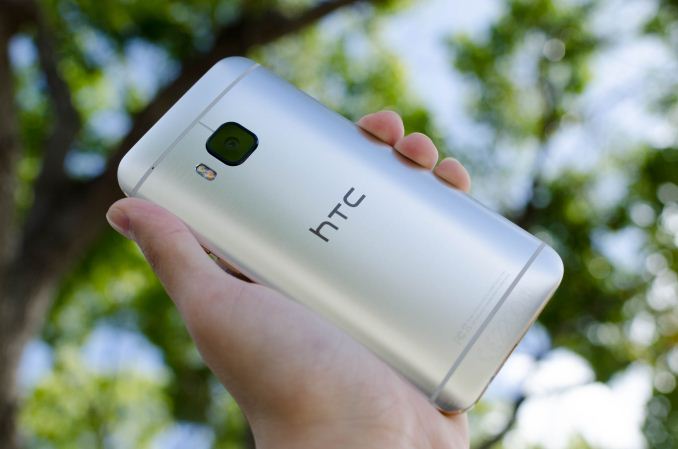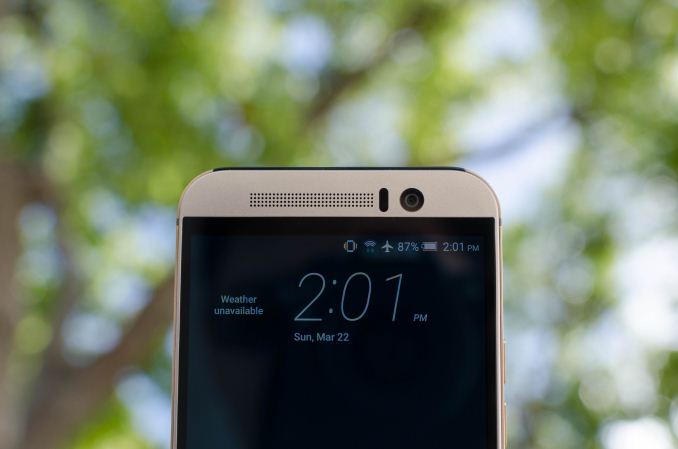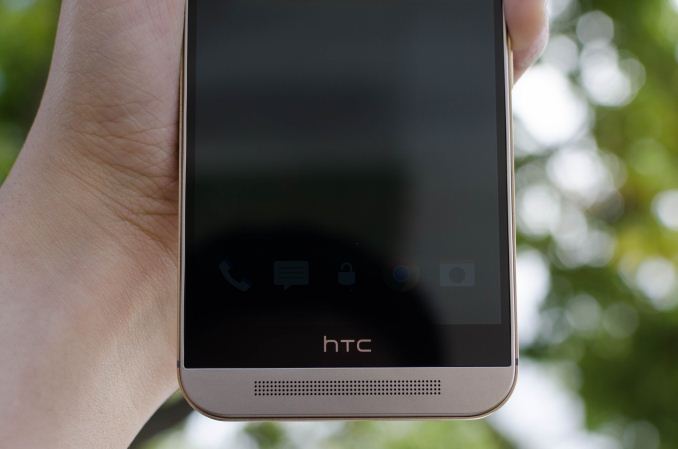The HTC One M9 Review: Part 1
by Joshua Ho on March 22, 2015 7:00 PM EST- Posted in
- Smartphones
- HTC
- Qualcomm
- Mobile
- Snapdragon 810
- One M9

For the most part, HTC’s story in the recent past has been well-understood. Starting with the G1, HTC was the first to adopt Android, with massive success as others lagged behind. However, around the time of the Sensation, we saw HTC’s fortunes peak and begin to fall. With the strength of Samsung’s success, HTC crumbled under competitive pressure as their product line became increasingly fragmented, with no real direction. HTC reacted with the One line of phones, but the One X was hurt by the use of Tegra 3 over Snapdragon S4 for most variants, the flexible back cover could easily damage antenna connectors and ruin reception, and in general the One X wasn’t really well-differentiated.
The One M7 was essentially the phone that saved HTC. While at the time it wasn’t as clear, the One M7 was ultimately a better phone than any flagship phone that competed with it. The display was and still is incredible, the design clearly differentiated and well-executed, Sense 5 was smooth and well-designed, the front-facing speakers made for amazing media experiences, and the camera was somewhat of a revelation at the time for its low light quality. The One M8 continued this by refreshing the M7 in some key areas, but areas like the camera weren’t really improved upon, the design was a bit too rounded, and the ergonomics of the bigger phone weren’t the greatest due to the top-mounted power button.
The One M9 attempts to take the M8 and address all of these issues. To get the basic changes out of the way, I’ve included the spec sheet below.
| HTC One M8 | HTC One M9 | |
| SoC | MSM8974ABv3 2.26 GHz Snapdragon 801 | MSM8994 2/1.5 GHz A57/A53 Snapdragon 810 |
| RAM/NAND | 2GB LPDDR3 16/32GB NAND + microSD |
3GB LPDDR4 32GB NAND + microSD |
| Display | 5” 1080p LCD | 5” 1080p LCD |
| Network | 2G / 3G / 4G LTE (Qualcomm MDM9x25 IP UE Category 4 LTE) | 2G / 3G / 4G LTE (Qualcomm UE Category 7/9 LTE) |
| Dimensions | 146.36 x 70.6 x 9.35mm max, 160 grams | 144.6 x 69.7 x 9.61mm max, 157 grams |
| Camera | 4.0 MP (2688 × 1520) Rear Facing with 2.0 µm pixels, 1/3" CMOS size, f/2.0, 28mm (35mm effective) and rear depth camera 5MP Front Facing, f/2.0 |
20MP Rear Facing w/ 1.12 µm pixels, 1/2.4" CMOS size, f/2.2, 27.8mm (35mm effective) 4MP Front Facing, 2.0 µm pixels, f/2.0 26.8mm (35mm effective) |
| Battery | 2600 mAh (9.88 Whr) | 2840 mAh (10.79 Whr) |
| OS | Android 5 with Sense 6 | Android 5 with Sense 7 |
| Connectivity | 802.11a/b/g/n/ac (WCN36880) + BT 4.0, USB2.0, GPS/GNSS, MHL, DLNA, NFC | 802.11a/b/g/n/ac (BCM4356) + BT 4.1, USB2.0, GPS/GNSS, MHL, DLNA, NFC |
| SIM Size | NanoSIM | NanoSIM |
As we can see, some of the primary areas of improvement include the new Snapdragon 810 SoC, more RAM, more internal storage, better cameras, and a bigger battery. As we’ll soon see, some of these might not be improvements. Before we get into the review though, it's important to emphasize that HTC released a major update to the software around Friday morning which significantly impacted key aspects of the experience, which include throttling performance and aspects of camera tuning. Although we have results for these areas from previous firmware builds, casual testing revealed that there were significant differences in many results. We will explore all of these changes in the second part of the review. This part of the review will only cover aspects which didn't change across firmware builds.
Design
At any rate, one of the more immediate aspects of the phone is the design. HTC has been a leader in the Android space for design and build quality for the past few years, and the M9 clearly shares its lineage with the M7 and M8. In some ways, it’s basically a combination of the two. The same front speaker design is shared with the M8, but the plastic bezel has been updated to surround the entire front of the device instead of just the speakers. It’s a bit unfortunate that the speaker grilles still aren’t made of aluminum, but I suspect that there are some cost and quality control concerns that are affecting this decision. The speakers appear to be mostly the same, but there's a new NXP TFA9895 amp/speaker protection IC, which should help improve quality and volume of the speakers.
One of the notably divisive elements of this phone remains the bottom bezel, often called the “logo bar”. It is a bit unfortunate that this remains, but we’re basically fighting physics here. Casual examination of any number of teardowns online will reveal that there’s a pretty significant bezel requirement for any smartphone. The only real question is how to best deal with it, and I suspect it may make more sense to either find a way to integrate three capacitive buttons on this bezel or move it to the top of the display to make typing less uncomfortable. Other than this, the front of the device is somewhat unremarkable. The corners have a noticeably tighter radius of curvature, but other than that there really isn’t much to discuss.
The side and back cover of the phone is really where most of the changes are. The power button has been moved from the top-right on the M8 to the center of the right side on the M9. Unfortunately, this makes the power button a bit too low for my taste. It’s hard to press it when holding the phone in my hand normally, but it’s extremely easy to press it on accident when setting it down. It would definitely help if the power button was higher, and if the volume buttons were moved to the left side of the phone. Other than this, HTC’s port configuration is pretty standard. The USB port and 3.5mm jack are both on the bottom of the phone but offset to the right to improve usability when the phone is in landscape with either port in use. It would be nice to see USB type C here, but given that the latest phones are still launching with microUSB ports I suspect there have been other issues preventing adoption in this case. The left side of the phone has nothing on it, and the top of the phone has a plastic window to allow things like the infrared port to work properly. Unfortunately, with the move to the Peel remote application it seems that the default application no longer supports receiving IR codes.
On the back of the phone, we see that the second camera for depth sensing is gone, and that the camera lens is now square instead of a circle and made of sapphire to avoid scratches that seemed to be an issue on the M8. There’s a camera hump, but it’s basically inconsequential here.The edge between the side and the back of the phone is also no longer rounded, and is sharp as there isn’t a chamfer. It turns out that this is actually pretty uncomfortable and even sharper than the M7 in the hand as a result. HTC claims that this is done for better grip, but in practice it feels like HTC may have pushed too far here. To their credit, the new brushed finish is awesome and managed to fix a lot of the issues with feel of the brushed finish with the M8. HTC states that the dual anodization finish of the M9 takes twice as long, and that the brushed finish is also quite difficult to pull off as yield is much lower than the typical sand-blasted finish of other aluminum unibodies. I’m sure some will appreciate this attention to detail, but I’m not sure most will notice the difference when compared to the M7 and M8. Overall, I can appreciate the improvements from the M8 but I’m not sure HTC took the right direction here, as they’ve dramatically increased cost and reduced yield of the back cover in order to achieve an effect that may be hard to appreciate in practice. The ergonomics of the phone have meaningfully improved, but the improvements in design overall are quite subtle and casual observers will probably view the M9 and M8 as basically interchangeable.














132 Comments
View All Comments
Midwayman - Tuesday, March 24, 2015 - link
With android it almost always seems to be misbehaving apps. Its hard to compare unless you keep the OS stock. I've spent a fair amount of time chasing down wakelocks.Notmyusualid - Sunday, March 22, 2015 - link
My gf noticed too.She went to buy a new Windows phone after she 'fell' into the pool this weekend, drowining the Nokia 820 I bought her. Ok, I dunked her...
But alas the top models were out of stock at the biggest shopping center available. Eventually she left with a Galaxy A7 (Octa core, 5.5" 1080, fast ram, dual sim) and whilst I'm impressed, she, not too much. She really wanted a Windows Phone it seems.
zodiacfml - Monday, March 23, 2015 - link
I feel bad. They've focused too much on the physical materials of the phone, hurting the other parts.They could have also went for a larger display at the same resolution to increase battery size and minimize bezels.
This will be competing with the S6 which is the phone to get in 2015 because of its very nice camera.
mchart - Monday, March 23, 2015 - link
A larger display is not what it needs. What it needs is the same display but in a chassis that is smaller and doesn't have all that useless area needlessly increasing the size of the phone.Impulses - Monday, March 23, 2015 - link
Pretty underwhelming, I'm starting to wonder whether I'll hold on to my current phone even longer than 2 years, it's the first one I've had for more than a year as it is. Z3c was the only thing that tempted me last year...mchart - Monday, March 23, 2015 - link
IMO the Z3C is the best phone in the market. It's just a shame it's been largely ignored.I'm an iPhone fan and the Z3C is the first Android running hardware that hasn't led to disappoint for me. Great battery life, great build quality, feels nice in normal usage, has top end hardware packed in, and is running pretty much vanilla Android.
It can be had for a really great price now too. Low $400s, and you can get it in that same price range direct from Sony with a 1 year warranty if you make a free student account to receive 10% off through them.
It's really the best phone if you can't stand/deal with these larger monsters that are frankly a pain to use on a day to day basis for simple things like phone calls.
sonny73n - Monday, March 23, 2015 - link
The Z3C has a few problems. It would be the best phone in the market if it had better display and protective glass. I wish my Z3C has the same display quality as the M7 and Gorilla 3 front and back glass.mchart - Monday, March 23, 2015 - link
The z3 has gorilla glass front and back. The display is high quality as well. It's just not 1080p. The ppi is still high enough for that size though.V900 - Monday, March 23, 2015 - link
Yeah, 1080p is really overkill for a phone right around 4 inches. I honestly couldn't tell the difference between 1080p 720p and the 1136*640 on a 4 inch screen in regular usage. As long as it's above 300 PPI few people would be able to tell...Impulses - Monday, March 23, 2015 - link
If I was buying a phone today I'd probably pick it over my Nexus 5 (are they even still selling the N5?), tho I'd have to switch carriers for it... I'm satisfied with Sprint in my area for now and that's one of the reasons I've kept the N5.A Z3c with Qi wireless charging and OIS would be the perfect compact Android phone IMO. Hopefully Sony doesn't abandon smaller devices (or the smartphone market altogether) any time soon.
Whatever they follow up the Z3c might just be the replacement for the N5 I've had since Nov 2013... I had three HTC phones before the, pretty happy with them, the One just hasn't done it for me.
Ergonomically it's always felt odd and it seems they're treading water in most other senses (no pun intended).